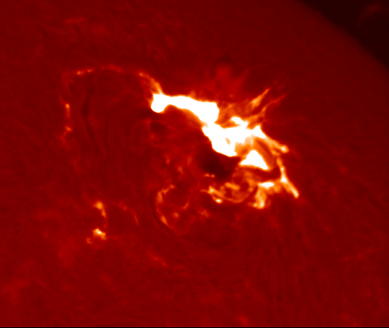Solar Flares
When a solar flare occurs, the magnetic energy that has built up in the solar atmosphere is suddenly released. As magnetic energy is being released, particles (including electrons, protons, and heavy nuclei) are heated and accelerated in the solar atmosphere. This energy is ten million times greater than the energy released from a volcanic explosion. Even so, it is less than one-tenth of the total energy emitted by the Sun every second!

|
Solar flares. Source: Sun-Earth Connection/NOAA.
|
There are usually three stages to a solar flare. The first is when the release of magnetic energy is triggered. In the second stage protons and electrons are accelerated and radio waves, hard x-rays (of plasma above 30 million degrees Kelvin), and gamma rays are emitted. The third stage is the gradual build up and decay of soft x-rays (of plasma from 10—30 million degrees Kelvin). Each of these stages can be as short as a few seconds or as long as an hour.
The frequency of flares coincides with the Sun's 11 year cycle. When the solar cycle is at a minimum, active regions are small and rare and few solar flares are detected. As the Sun approaches the maximum part of its cycle, flares increase.
Flares are in fact difficult to see against the bright emission from the photosphere. Specialized scientific instruments are needed. The radio and optical emissions from flares can be observed with telescopes on the Earth. Energetic emissions such as x-rays and gamma rays require telescopes located in space, because these emissions don't penetrate the Earth's atmosphere.
You can't view a solar flare by simply staring at the Sun. You should never look directly at the Sun because you can seriously damage your eyes.
Back